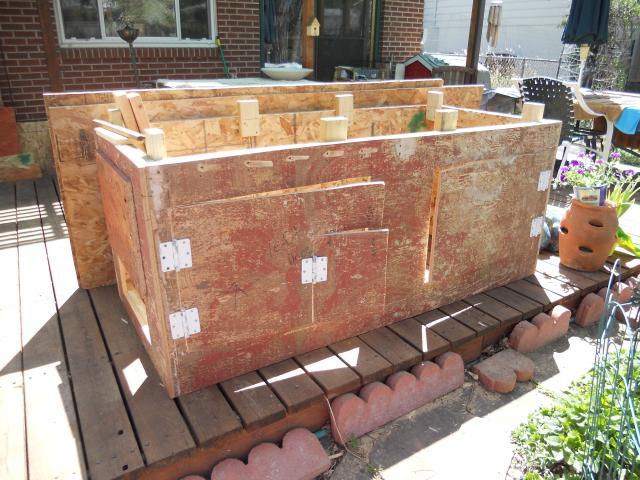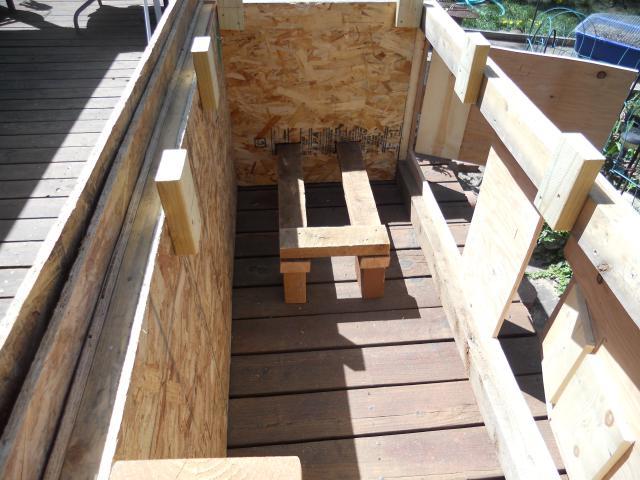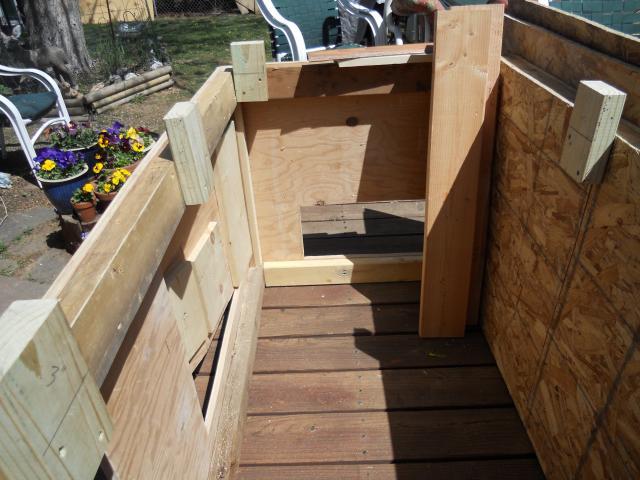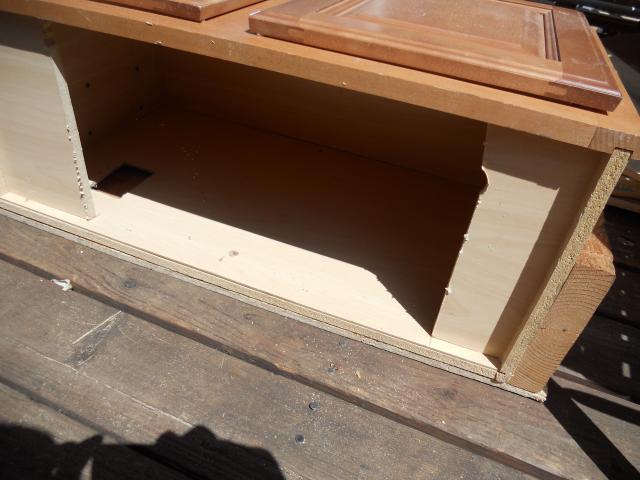- Mar 25, 2011
- 40
- 1
- 22
Hi,
I didn't have the wherewithal to take pics today, but I will try to get some posted by 11 AM in the morning (MST -- I'm in Boulder, CO).
Before we paint and try to get the coop in the pen (which is going to take some weightlifting STRONG people), I was hoping to double check some of my concerns.
My engineering roomie (bless him!) and I 'finished' the hen house that will go in a very secure, very short, not wide turtle pen. I'm using two concrete blocks on top of each other for the supports for the coop (6 pairs), which means we could only make the coop 30" tall . . . . It is about 73" long and 33" wide, so 6 feet by about 2 3/4 ft. It's going to be very difficult to get it set up in the pen even as narrow and short as it is now . . . . But the chickens will be able to go underneath the coop, so they'll have the benefit of still having a 'run' of about 50 square feet, a bit over the 10 sq ft per chicken needed.
For ventilation, we've put eight (8) 6" 2x4's that stick up above the walls 3"; the OSB roof will be attached to the top of the 2x4's so there will be 3" all around the coop top for ventilation (minus the 8 2x4 widths that are the supports). My housemate has read the Patandchickens ventilation page (as I have), he's done the math (engineer), and has had to reassure me several times that we have about 20 times the ventilation necessary for 4 chickens (visually, the ventilation doesn't seem much at all!).
During the heat of the summer, we'll be keeping the two cleanout doors to the coop open as well ( think they're 24" wide by 19" tall each); during the winter, we'll close the big doors and just have the pop door (10" wide x13" tall out of one of the cleanout doors) open.
The nesting box is a cabinet turned on its back so that its doors open at the top; it's about 24" wide, 16" deep, and 10 1/2" tall when it's turned that way.
We presently have NO ventilation in the nest boxes except that it's external to the coop and we've cut openings into the hen house for chicken access. It has to be on the south side of the coop, where the entrance to the pen is, for easy removal of eggs. Underneath the coop will be cool, since the placement of the coop within the pen in the back corner backs up to vegetation in the other neighbors' yards, and there are trees that will shade the pen for part of the day as well. I'm a bit worried now that the hens will lay underneath the coop, instead of in the nest box (especially if the nest box is too hot for them!). It would be very difficult to get under the coop to get eggs, so it's something I want to head off if I can. (The pullets -- at least I hope they're all pullets -- are about 7 weeks old now, I think -- not sure, I'll have to ask my other housemate). We're planning on leaving the pop door open, because it's the pen that's secure, not the hen house -- and that way the hens can come and go as they please into it. I'll also let them out in our yard some, but only when I'm there to supervise with the help of one of our dogs (lots of cats in the neighborhood, not to mention raccoons, rats, etc.).
The hens like privacy and dark, secluded spots for egg-laying, so how can we provide ventilation for them and still give them the privacy/darkness they want?
Do we need to add ventilation to the nest box/cabinet at all?
Since the 3" under the roof goes all the way around the coop, does that provide enough ventilation for the nest box as well?
If I shingle the coop roof, will that help keep the coop cool? ( I probably don't have enough shingles to do the entire roof -- it's 34" wide by 8 ft long, so it'll cover the nest boxes, to some extent.)
Is the 3" all the way around the coop enough ventilation for the humidity during the summer and winter?
Do we need to add a window (even if it doesn't open and close) above the nest boxes for more light inside the coop? Or window(s)? The coop is pretty dark if the cleanout doors are closed, even when it's on the deck where we built it, and not in the (often) shaded pen . . . .
The floor is separate from the house itself, so there won't be any way to caulk the floor/wall joining until we actually get the house IN the pen itself. We don't have anywhere to put the chickens (safely) for more than a few hours (as long as it's nice so I can stay out there with the dogs) -- so I won't be able to paint the caulking that could go in between the floor and the walls. Will that matter? I did buy some quick-drying caulk that dries in about 40 minutes (it's painter's caulk) -- but I'm not sure about painting INSIDE the coop and then expecting the pullets to go in there within a few hours. I don't know how long the Kilze paint takes to dry, but that's what we'll be using inside the coop (and outside, as well). Is it ok to just dust with DE in the cracks between the floor and the walls as soon as that gets delivered (should be here next week), instead of trying to paint it? Should I definitely caulk there (I'm assuming I should -- and just plan on recaulking if need be).
Am I just being a worrywart???
THANKS for any info any of you can give in answer to these questions (or any other comments you can think of that I need to know). As I said, I'll try and get some pictures posted by late morning May 10th . . . . They'll be in this thread . . . .

carroll
I didn't have the wherewithal to take pics today, but I will try to get some posted by 11 AM in the morning (MST -- I'm in Boulder, CO).
Before we paint and try to get the coop in the pen (which is going to take some weightlifting STRONG people), I was hoping to double check some of my concerns.
My engineering roomie (bless him!) and I 'finished' the hen house that will go in a very secure, very short, not wide turtle pen. I'm using two concrete blocks on top of each other for the supports for the coop (6 pairs), which means we could only make the coop 30" tall . . . . It is about 73" long and 33" wide, so 6 feet by about 2 3/4 ft. It's going to be very difficult to get it set up in the pen even as narrow and short as it is now . . . . But the chickens will be able to go underneath the coop, so they'll have the benefit of still having a 'run' of about 50 square feet, a bit over the 10 sq ft per chicken needed.
For ventilation, we've put eight (8) 6" 2x4's that stick up above the walls 3"; the OSB roof will be attached to the top of the 2x4's so there will be 3" all around the coop top for ventilation (minus the 8 2x4 widths that are the supports). My housemate has read the Patandchickens ventilation page (as I have), he's done the math (engineer), and has had to reassure me several times that we have about 20 times the ventilation necessary for 4 chickens (visually, the ventilation doesn't seem much at all!).
During the heat of the summer, we'll be keeping the two cleanout doors to the coop open as well ( think they're 24" wide by 19" tall each); during the winter, we'll close the big doors and just have the pop door (10" wide x13" tall out of one of the cleanout doors) open.
The nesting box is a cabinet turned on its back so that its doors open at the top; it's about 24" wide, 16" deep, and 10 1/2" tall when it's turned that way.
We presently have NO ventilation in the nest boxes except that it's external to the coop and we've cut openings into the hen house for chicken access. It has to be on the south side of the coop, where the entrance to the pen is, for easy removal of eggs. Underneath the coop will be cool, since the placement of the coop within the pen in the back corner backs up to vegetation in the other neighbors' yards, and there are trees that will shade the pen for part of the day as well. I'm a bit worried now that the hens will lay underneath the coop, instead of in the nest box (especially if the nest box is too hot for them!). It would be very difficult to get under the coop to get eggs, so it's something I want to head off if I can. (The pullets -- at least I hope they're all pullets -- are about 7 weeks old now, I think -- not sure, I'll have to ask my other housemate). We're planning on leaving the pop door open, because it's the pen that's secure, not the hen house -- and that way the hens can come and go as they please into it. I'll also let them out in our yard some, but only when I'm there to supervise with the help of one of our dogs (lots of cats in the neighborhood, not to mention raccoons, rats, etc.).
The hens like privacy and dark, secluded spots for egg-laying, so how can we provide ventilation for them and still give them the privacy/darkness they want?
Do we need to add ventilation to the nest box/cabinet at all?
Since the 3" under the roof goes all the way around the coop, does that provide enough ventilation for the nest box as well?
If I shingle the coop roof, will that help keep the coop cool? ( I probably don't have enough shingles to do the entire roof -- it's 34" wide by 8 ft long, so it'll cover the nest boxes, to some extent.)
Is the 3" all the way around the coop enough ventilation for the humidity during the summer and winter?
Do we need to add a window (even if it doesn't open and close) above the nest boxes for more light inside the coop? Or window(s)? The coop is pretty dark if the cleanout doors are closed, even when it's on the deck where we built it, and not in the (often) shaded pen . . . .
The floor is separate from the house itself, so there won't be any way to caulk the floor/wall joining until we actually get the house IN the pen itself. We don't have anywhere to put the chickens (safely) for more than a few hours (as long as it's nice so I can stay out there with the dogs) -- so I won't be able to paint the caulking that could go in between the floor and the walls. Will that matter? I did buy some quick-drying caulk that dries in about 40 minutes (it's painter's caulk) -- but I'm not sure about painting INSIDE the coop and then expecting the pullets to go in there within a few hours. I don't know how long the Kilze paint takes to dry, but that's what we'll be using inside the coop (and outside, as well). Is it ok to just dust with DE in the cracks between the floor and the walls as soon as that gets delivered (should be here next week), instead of trying to paint it? Should I definitely caulk there (I'm assuming I should -- and just plan on recaulking if need be).
Am I just being a worrywart???
THANKS for any info any of you can give in answer to these questions (or any other comments you can think of that I need to know). As I said, I'll try and get some pictures posted by late morning May 10th . . . . They'll be in this thread . . . .

carroll





